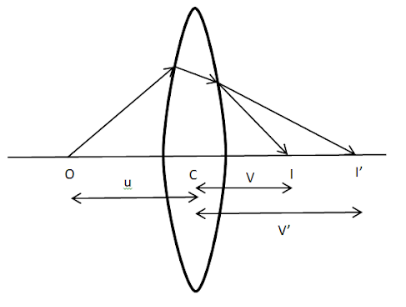
Establish the refraction formula for a thin lens:
Answer
442.2k+ views
Hint:Consider the lens as two surfaces and not one. The rays are going from denser to rarer medium or vice versa that means a change of medium is there. Also,it is a thin lens so use the formula for thin lens that is thickness approximately null.
Complete step by step answer:

Let’s take a convex lens L having refractive index
According to the refraction formula for a convex spherical surface:
Where
For surface AB,we have
Substituting these values in the refraction formula, we get
For surface A’B’,we have
Substituting these values in the refraction formula, we get
Multiplying by
Adding equation 1 and 2, we get
Now if the focal length of lens L is f, we know that the formula for focal length is
Substituting equation 4 in equation 3,we get
Hence we establish the formula for refraction of a thin lens:
Note: The refractive index of both the surfaces will be different as during the first surface , rays go from rarer to denser medium and in the second surface, rays travel from denser to rarer medium. This is the most common mistake. Treat the lens as two spherical surfaces and apply the refraction formula for spherical convex surface.
Complete step by step answer:

Let’s take a convex lens L having refractive index
According to the refraction formula for a convex spherical surface:
Where
For surface AB,we have
Substituting these values in the refraction formula, we get
For surface A’B’,we have
Substituting these values in the refraction formula, we get
Multiplying by
Adding equation 1 and 2, we get
Now if the focal length of lens L is f, we know that the formula for focal length is
Substituting equation 4 in equation 3,we get
Hence we establish the formula for refraction of a thin lens:
Note: The refractive index of both the surfaces will be different as during the first surface , rays go from rarer to denser medium and in the second surface, rays travel from denser to rarer medium. This is the most common mistake. Treat the lens as two spherical surfaces and apply the refraction formula for spherical convex surface.
Recently Updated Pages
Master Class 12 Economics: Engaging Questions & Answers for Success

Master Class 12 Maths: Engaging Questions & Answers for Success

Master Class 12 Biology: Engaging Questions & Answers for Success

Master Class 12 Physics: Engaging Questions & Answers for Success

Master Class 12 Business Studies: Engaging Questions & Answers for Success

Master Class 12 English: Engaging Questions & Answers for Success

Trending doubts
Which one of the following is a true fish A Jellyfish class 12 biology CBSE

Which are the Top 10 Largest Countries of the World?

a Tabulate the differences in the characteristics of class 12 chemistry CBSE

Why is the cell called the structural and functional class 12 biology CBSE

Differentiate between homogeneous and heterogeneous class 12 chemistry CBSE

Derive an expression for electric potential at point class 12 physics CBSE




